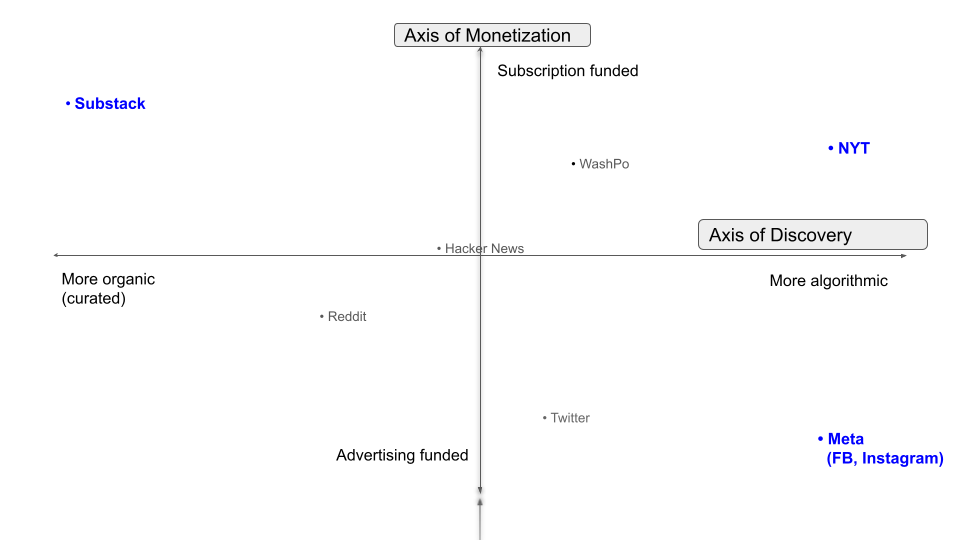Subscriptions and Advertising in Digital Media - Either/Or or Both/And
20 Apr 2022Digital media is a stronghold of subscription-based e-commerce, but while this is often considered the opposite of the advertising-based revenue model, in practice, many companies rely on both forms of commerce.
Digital news media is converging rapidly on the subscription model as its preferred form of monetization. A recent tier of subscription-only newsletter companies (Substack is the best known of these), traditional media companies like The New York Times, and even social media companies like Twitter, all offer paid subscriptions to consumers. One question we ask ourselves is “are subscriptions and advertising mutually exclusive?” The answer, we discoverd is that they are not exclusive at all.
Our exploration was inspired by a post entitled The Ideology of Substack by Nathan Baschez, one of the movers behind the newsletter consortium, Every, and previously an early employee at Substack. In the post, Baschez observes that prior to launch, Substack’s founders diagnosed two central problems of digital media: “Advertising…which rewards publishers for attracting attention” and “Engagement Algorithims” which promote virality based on emotions such as outrage.
According to the post, Substack was shaped by its founders’ hypothesized solutions to each problem: 1) Paid subscriptions replace advertising for monetization; and 2) email inboxes replace algorithmically-generated content feeds. I want to focus here on these two “central problems” and suggest that digital media can be situated, correspondingly, on two axes: an Axis of Monetization (with advertising on one side and subscriptions on the other)and an Axis of Discovery (algorithmic on one side and organic/curated on the other):
This is easier to draw than to explain in words, so here’s how this coordinate system looks with several prominent contemporary media companies plotted on it.

Even a cursory application of this framework reveals some surprising findings.
Substack is situated on the extreme upper left of the coordinate grid - it accepts no advertising, relies 100% on subscription revenue, and doesn’t have any form of “news feed” or other algorithmic discovery. There likely are other similar properties, but, offhand, I can’t think of any. Substack is by far the most ardent proponent of its founders’ opinionated view of how digital media should work.
Another company which has been promoting its reliance on reader subscriptions is the New York Times, situated in the upper right quadrant of the coordinates. Not only do NYT website/apps have a paywall, but content that used to be given away with the physical paper such as food recipes and the crossword puzzle have been spun off as independent paid subscriptions. Its recently announced acquistion of the subscription sports journalism site, The Athletic, possibly foreshadows a world where the NYT sports section is a paid add-on subscription rather than part of the traditional paper.
As any subscriber who uses the Times apps or website knows, stories are pushed at users algorithmically. On occasions where I see “dead tree” edition of the paper, I’m always surprised that I see bylines of writers who I assume had left the NYT and topics that I rarely see online. And despite the fact that subscriptions to the paper, Food, and Puzzles apps cost a combined several hundred dollars per year, the NYT still targets me with advertising whenever I use its site or apps.
For all of these reasons I have located the NYT on the upper right of the grid: heavily dependent on subscription revenue, but also on advertising. And probably because of the advertising, they are algorithmically promoting articles which generate the most clicks.
Meta, parent company of Facebook and Instagram, famously depends on targeted advertising in its algorithmically-generated news feed. Not surprisingly, Facebook invented many “surveillance capitalism” technologies (not because it intended to become enmeshed in political controversy, but because those technologies enable it to target advertising profitably). However, even Meta has been incorporating subscriptions into its commerce mix with the 2021 introduction of Creator Subscripitons which enable social media influencers to sell subscriptions to their followers (Meta, of course, takes a cut). Because of its dependence on advertising and algorithmic targeting, Meta’s products are located on the lower right quadrant of my grid.
The only quadrant which is empty (with the exception arguably of Reddit) is the lower left. That’s because in order to compete effectively in the digital advertising marketplace, it’s required to do some algorithmic targeting.
The takeaway here is that these days it is rare for companies to be entirely dependent on either subscriptions or on advertising. While many companies rely on algorithims to decide what content and advertising to show users, it’s also somewhat unusual for a company to be entirely dependent on them. Most companies, lacking the enormous resources of the NYT or Facebook rely on a mixture of algorithms, curation and old-fashioned publicity to promote discovery of their content.